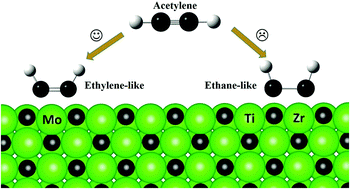Acetylene adsorption on δ-MoC(001), TiC(001) and ZrC(001) surfaces: a comprehensive periodic DFT study†
Abstract
A comprehensive study of acetylene adsorption on δ-MoC(001), TiC(001) and ZrC(001) surfaces was carried out by means of calculations based on periodic density functional theory, using the Perdew–Burke–Ernzerhof exchange–correlation functional. It was found that the bonding of acetylene was significantly affected by the electronic and structural properties of the carbide surfaces. The adsorbate interacted with metal and/or carbon sites of the carbide. The interaction of acetylene with the TiC(001) and ZrC(001) surfaces was strong (binding energies higher than −3.5 eV), while moderate acetylene adsorption energies were observed on δ-MoC(001) (−1.78 eV to −0.66 eV). Adsorption energies, charge density difference plots and Mulliken charges suggested that the binding of the hydrocarbon to the surface had both ionic and covalent contributions. According to the C–C bond lengths obtained, the adsorbed molecule was modified from acetylene-like into ethylene-like on the δ-MoC(001) surface (desired behavior for hydrogenation reactions) but into ethane-like on TiC(001) and ZrC(001). The obtained results suggest that the δ-MoC(001) surface is expected to have the best performance in selective hydrogenation reactions to convert alkynes into alkenes. Another advantage of δ-MoC(001) is that, after C2H2 adsorption, surface carbon sites remain available, which are necessary for H2 dissociation. However, these sites were occupied when C2H2 was adsorbed on TiC(001) and ZrC(001), limiting their application in the hydrogenation of alkynes.



 Please wait while we load your content...
Please wait while we load your content...